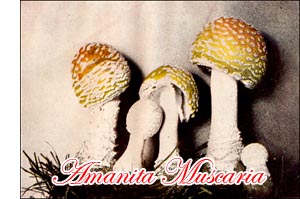Amanita Muscaria
 Amanita muscaria
Amanita muscariaFly Amanita (Poisonous)
Cap or Pileus - Orange red to pale yellow or almost white. The young plants are brighter, arid fade from the margin inward as the plant matures. Floccose scales, the wrapper remains, are scattered on the cap. The margin is often striate. 3-6 inches broad.
Stem or Stipe - White or slightly tinged with yellow. Pithy or hollow. Base not broad and abrupt, but ovate, covered with the scaly margins of the wrapper. 4-6 inches long.
Veil and Ring or Annulus - The veil covers the gills of the young plant, and later is seen as a collar-like ring on the stem.
Gills or Lamellae - White or slightly tinged with yellow. Various in length ; short ones terminating in length with almost vertical abruptness.
Spores - White, broadly elliptical.
Flesh - White, tinged with yellow under the epidermis.
Habitat - Along roadsides, on borders of fields, in groves of coniferous trees. It prefers poor soil, gravelly or scanty. It grows singly, not in groups.
Time - June until freezing weather.
Young Plant - This is at first egg-like, then dumb-bell shaped. As the parts within expand, the wrapper breaks up into scales, so that the convex, unexpanded cap is densely covered with more or less concentric fragments of the wrapper, and the bulbous stem is covered with rings of fringy scales. As the stem expands, these scales are left on the bulbous base, while the fragments on the cap are more widely separated by the growth of the cap.
The fly amanita is a very conspicuous and handsome species. There are conflicting statements concerning the properties of this fungus; some claim that it is edible, and yet it is known to have caused much sickness and many deaths.
It caused the death of the Czar Alexis of Russia, and of the Count de Vecchi in Washington. It is said that it is cooked and eaten
by the Russians, and still it is or: record that several French soldiers ate of it in Russia and became very ill.
The Siberians steep dried specimens of the fly amanita in whortleberry juice, and thus make a drink which produces an
intoxication similar to that produced by the "haschisch" and "majoon" of the East.
There is something about it particularly attractive to flies, and yet for them to sip its juices means death, as may be seen by the circle of dead flies lying on the ground under the shadow of its cap. The chief poison of this fungus is an alkaloid called muscarine, which paralyzes the nerves controlling the action of the heart. Injections of atropine in doses of from one one-hundredth to one-fiftieth of a grain are employed as an antidote for this poison. In addition, the most powerful emetics are used.
Amanita Muscaria picture